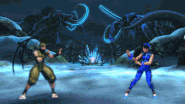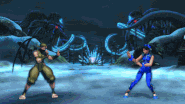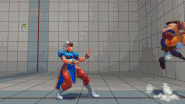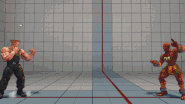Command inputs are the "directions" for the use of attacks in the Street Fighter series and other fighting games. Detailed below are the various type of inputs used in the series, as well as a basic guide to reading inputs and performing them.
Notes
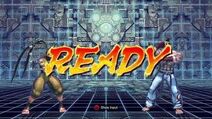
Ibuki SFXT Trials
In this Trial video, inputs are shown, showing the timing required in modern Street Fighter games to pull off sequences
All inputs mentioned are meant to be read from the "default" perspective of a right-facing player character, unless noted otherwise. For a left-facing character, simply invert the direction.
For the sake of clarity, motions are "performed" in attack articles as opposed specifically to "pressed"; this is done for the sake of simplicity, and to acknowledge the use of arcade sticks as well as direction pads. In addition, the motions themselves will be underlined; hover over the underlined portions to see how to perform them. A link to this page will be provided next to the underlined section in the event further clarity is needed.
'Simple' Input
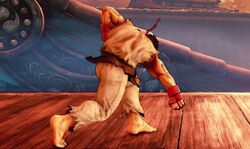
Ryu's Collarbone Breaker is an example of a "simple input" unique attack.
Above is an example of what a unique attack's input looks like - a simple direction (right), and a button (medium punch). For the most part, unique attack commands require specific buttons:
'Complex' Inputs
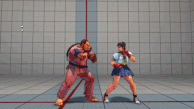
Dan's Koryuken is an example of an attack with "complex" inputs.
The above input is that of the Shoryuken, a special attack. 'Complex' inputs like these require at least one 'complex' motion (forward, down, down-forward) and a button (punch). Special attacks have properties that vary based on the specific button pressed; a light punch Shoryuken will have less height than a heavy punch Shoryuken, for example.
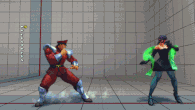
Rose's Aura Soul Spark is an example of an attack that uses a complex super input.
This is a common input for high-powered moves, e.g. Super Combos; such moves often use two motions (two quarter-circle forward motions, charging back, then moving forward, back, and forward, etc.) and at least one punch or kick button.
The classification of 'simple' and 'complex' inputs shown above are for the purpose of distinguishing between the two types.
Button-only Inputs
Certain special attacks can be performed with the use of only buttons; depending on how the controller/arcade stick is mapped, certain moves such as the Double Lariat can be performed with only one button.
Tapping
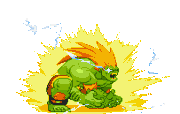
Above is the input used for a few special moves, such as the Hundred Hand Slap. Attacks that require the player to tap buttons rapidly in order to execute them require the buttons to be pressed at least 5 times; the more the button is tapped, the longer the attack is performed.
Tapping is also optional for certain moves (e.g. Rolling Thunder and Shoryuu Cannon), and is used in those instances to increase damage and hits. In the Marvel vs. Capcom series, most Hyper Combos are "mashable", and inflict more damage if the player rapidly taps the attack buttons as it executes.
Holding
Certain attacks (e.g. Turn Punch) require the player to hold a button(s) for a set period of time and then release them, at which point the move is performed.
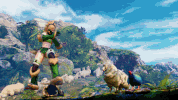
Kunai Ikkinage is an example of a "hold-based" input.
Moves like Fuhajin allow the player the option to hold the button if they wish; often, this serves to delay the move until a later point in the match where it can be of use.
Components
Along with the eight basic directions are various motions (an example of which is show in the complex input above). The types of motions a player uses ultimately depends on the character chosen.
Note that any mentions of difficulty in performing a motion mentioned below is based off a general overview. Actual difficulty with the motions varies with the experience of a player.
Circle Motions
Quarter-circle Motions
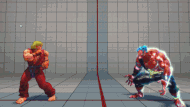
Ken's Hadouken is an example of a quarter-circle motion attack.
Quarter-circle motions (or "Fireball motions", after the informal name for many projectiles) are performed by moving the stick or pressing the pad in a 90° motion (e.g. down, down-forward, forward or down, down-back, back as shown above). They are the most commonly used motions in special attack inputs, and appear in the moveset of many different character types, from "shotos" like Ryu and Ken to grapplers like Hugo and Zangief. They can be considered the most 'basic' motions as a result.
Of note is that, in the Street Fighter III series, all Super Arts (excluding Hyper Bomb, Gigas Breaker, Raging Demon and Kongou Kokuretsuzan) use two quarter-circle motions and a punch or kick button. All of Street Fighter V's Critical Arts, which serve a similar purpose to Super Arts, use two quarter-circle motions in their inputs (except for Bolshoi Russian Suplex, Sonic Hurricane, and Shun Goku Satsu).
Half-circle Motions
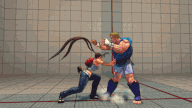
Raida is an example of a half-circle motion attack.
Half-circle motions are performed by moving the stick or pressing the pad in a 180° motion (e.g. back, down-back, down, down-forward, forward). The direction varies with the special attack. They appear somewhat less frequently (and especially the diagonal ones), though they appear in fighting styles that are just as varied. But in other fighting games they can be used for simulation moves
Full-circle Motions
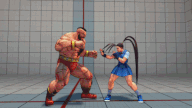
Zangief's Spinning Piledriver is an example of a '360' attack.
Full-circle (or 360°) motions are rare in special attack inputs, and can be performed clockwise or counterclockwise. Characters that use grapple moves - such as Zangief and T. Hawk - have inputs that use many half-circle and full-circle motions in attack inputs. They are comparatively rare when compared to the above motions, which can be attributed to its relative difficulty.
In addition to the 360° spin, several throw-based Super and Ultra Combos make use of two full-circle motions, often referred to as a 720° motion. These are much harder to execute in general, and, barring high skill, most always require the user to jump into the attack or use a move to keep the user earthbound. Other ways to pull off a 720° motion is after a dash or as a reversal.
In the Street Fighter IV series, full-circle motions were made more lenient, requiring only six directions instead of eight. This makes it possible to perform full-circle special attacks without buffering.
Shoryuken Motions
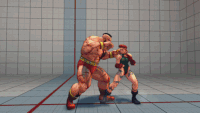
Cammy's Cannon Spike is an example of a 'Shoryuken motion' Attack.
Shoryuken motions are performed by holding the stick or pressing the direction pad in an 'Z' motion, i.e. forward, down, down-forward; some moves use a "reverse Shoryuken" motion that is performed with an 'S' motion, i.e. back, down, down-back. Shoryuken motions are often used for "upper"-type attacks that serve as anti-air attacks (e.g. Shoryuken, Jet Upper, Tomahawk Buster), as well as most teleport attacks.
Charge Motions

"Charging" is performed by holding the stick or pressing the direction pad down and/or away from the opponent for at least one second, and then moving forward and/or up. Charges can be performed mid-combo, depending on when the charge is started. Charges can be performed diagonally as well; holding down-back can be followed up by either an upward or forward move, as well as crouch blocking during the charge, and by jumping backwards, allowing charge characters to use their moves using charge inputs as soon as they land. Charging can occur at any point in a round, even including the time before the round starts.
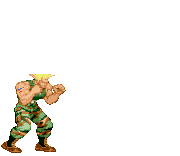
A "charge character" is a character whose moveset largely or entirely consists of moves with charge inputs; such characters include Guile, Urien, Juni and Blanka. Some characters like Chun-Li and Necalli have a mix of both charge and traditional moves. Charge characters have a distinctive playstyle as they effectively cannot use their special moves "on demand," requiring them to either back away, crouch, block or buffer with other moves to execute their special moves.
Backward-then-Forward Motions
Backward-then-Forward Motions are uncommon inputs that are used exclusively to execute Super or Ultra Combos. Always executed after a backward charge and then a forward motion, backward-then-forward motions are performed by moving the stick or pressing the directional pad, as the name implies, backward then forward. Only a small handful of moves use the backward-then-forward motion, and the list has been trimmed down to only currently consisting of Guile's Sonic Hurricane and Sonic Tempest in Street Fighter V.
Delta Motions
Delta motions (named for their resemblance to the Greek letter) are some of the very rarest inputs, and are, like backward-then-forward motions, exclusively used to execute Super and Ultra Combos (e.g. Head Press Nightmare, Flying Barcelona Special, Rolling Izuna Drop.) Always executed after a diagonal backward charge, delta motions are performed by moving the stick or pressing the directional pad in a triangular motion, i.e. down-forward, down-back, and up-forward. The relative difficulty of moving the stick precisely into these corners (and the directional pad even more so) helps account for its rarity—and as with backward-then-forward motions, only a small handful of moves use the delta motion, and the list has been continually trimmed down as the series has progressed, to the point where, in Street Fighter V, the motion is currently non-existent.
Trivia
- In the Street Fighter II era CPU opponents usually pretended or simply bypassed charge motions. This can be seen mostly with Guile when you jump to him he will usually duck for a very brief time or not crouch at all to use Flash Kick.
- Chun-Li's attacks occasionally become motion inputs rather than charge.

